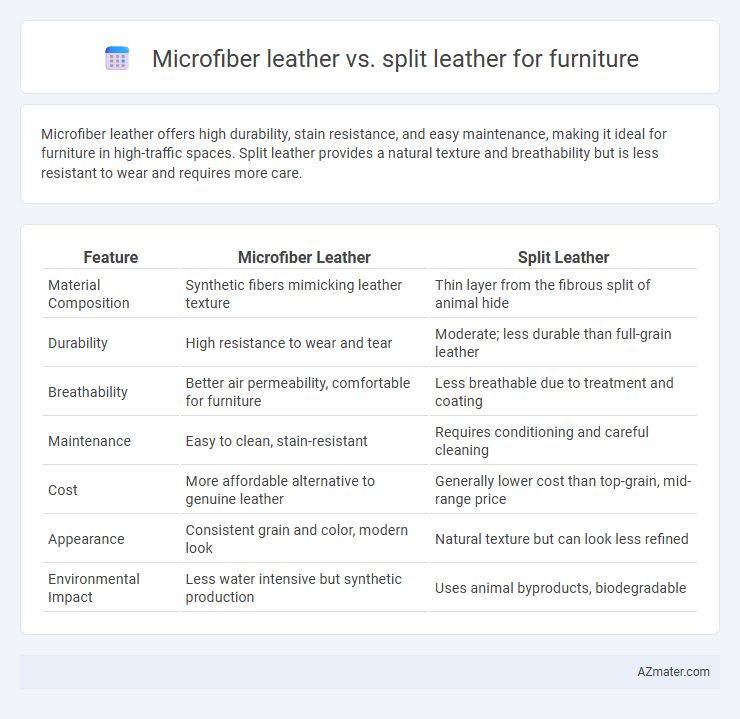Microfiber leather offers high durability, stain resistance, and easy maintenance, making it ideal for furniture in high-traffic spaces. Split leather provides a natural texture and breathability but is less resistant to wear and requires more care.
Table of Comparison
| Feature | Microfiber Leather | Split Leather |
|---|---|---|
| Material Composition | Synthetic fibers mimicking leather texture | Thin layer from the fibrous split of animal hide |
| Durability | High resistance to wear and tear | Moderate; less durable than full-grain leather |
| Breathability | Better air permeability, comfortable for furniture | Less breathable due to treatment and coating |
| Maintenance | Easy to clean, stain-resistant | Requires conditioning and careful cleaning |
| Cost | More affordable alternative to genuine leather | Generally lower cost than top-grain, mid-range price |
| Appearance | Consistent grain and color, modern look | Natural texture but can look less refined |
| Environmental Impact | Less water intensive but synthetic production | Uses animal byproducts, biodegradable |
Introduction to Microfiber Leather and Split Leather
Microfiber leather is a synthetic material made from finely woven polyester fibers combined with a polyurethane coating, offering high durability, stain resistance, and a soft texture ideal for furniture upholstery. Split leather, derived from the lower layer of animal hide, is more porous and less durable than top-grain leather but provides a natural leather appearance at a lower cost. Microfiber leather's uniform structure makes it easier to clean and maintain compared to split leather, which tends to absorb moisture and stains more readily.
Material Composition and Manufacturing Process
Microfiber leather consists of a polyester and polyurethane blend woven into a dense fabric that mimics natural leather's texture and durability, using advanced spinning and coating techniques to achieve water resistance and softness. Split leather is derived from the fibrous lower layer of animal hide, separated from the top grain and typically buffed or coated to improve appearance but lacks the same uniformity and resistance properties as microfiber leather. Manufacturing microfiber leather involves precise chemical processing and layering to create a consistent surface, whereas split leather undergoes mechanical splitting and surface treatment that emphasizes natural fiber characteristics.
Appearance and Texture Differences
Microfiber leather offers a smooth, uniform appearance with a consistent texture, mimicking genuine leather while providing enhanced durability and stain resistance. Split leather, derived from the lower layer of animal hide, has a more natural, rugged texture that varies in grain and is often coated or embossed to improve appearance. The soft, suede-like feel of split leather contrasts with the sleek, synthetic finish of microfiber, influencing both aesthetic appeal and tactile experience in furniture design.
Durability and Longevity Comparison
Microfiber leather offers superior durability compared to split leather, resisting wear, stains, and fading thanks to its synthetic fibers and PU coating. Split leather, derived from the lower layers of animal hides, is more prone to cracking and peeling over time despite its natural texture. For long-term furniture use, microfiber leather provides enhanced longevity and maintains appearance better in high-traffic environments.
Comfort and Softness for Furniture Use
Microfiber leather offers superior softness and a smooth texture, making it highly comfortable for extended furniture use. Split leather, derived from the lower layer of cowhide, tends to be less supple and can feel rougher, impacting comfort levels negatively. The dense, fine fibers of microfiber leather also provide better breathability and cushioning, enhancing overall seating comfort.
Maintenance and Cleaning Requirements
Microfiber leather offers superior stain resistance and requires minimal maintenance, as its dense synthetic fibers repel liquids and dirt effectively. Split leather demands more frequent conditioning and careful cleaning to prevent drying and cracking, given its porous surface that absorbs spills easily. Regular vacuuming and prompt spot-cleaning with mild soap are recommended for both materials to preserve their appearance and durability.
Cost and Affordability Analysis
Microfiber leather offers a cost-effective alternative to split leather, with prices typically 30-50% lower, making it ideal for budget-conscious furniture buyers. This synthetic material combines affordability with durability and stain resistance, reducing long-term maintenance costs compared to natural split leather. While split leather provides a premium, natural look and breathability, its higher price point and susceptibility to wear increase overall expenses.
Environmental Impact and Sustainability
Microfiber leather requires fewer natural resources and generates less waste compared to split leather, making it a more sustainable option for furniture. Split leather production involves extensive animal farming, leading to higher greenhouse gas emissions and deforestation, which negatively impact the environment. The durability and recyclability of microfiber leather also contribute to its lower environmental footprint in furniture applications.
Applications in Furniture Design
Microfiber leather, known for its durability and stain resistance, excels in modern furniture designs requiring easy maintenance and longevity, often used in sofas and recliners. Split leather, derived from the fibrous part of the hide, offers a more affordable option with a natural leather appearance, making it suitable for traditional and rustic furniture pieces like armchairs and ottomans. Both materials cater to distinct design aesthetics and usage scenarios, with microfiber leather favored in high-traffic areas and split leather chosen for decorative appeal.
Which is Better for Furniture: Microfiber or Split Leather?
Microfiber leather offers superior durability, stain resistance, and ease of maintenance compared to split leather, making it ideal for high-traffic furniture in homes with children or pets. Split leather, derived from the lower layers of animal hides, is less durable and more prone to wear and tear but provides a more authentic leather texture and appearance. Choosing between microfiber and split leather depends on balancing budget, durability needs, and desired aesthetic quality for your furniture.

Infographic: Microfiber leather vs Split leather for Furniture
 azmater.com
azmater.com